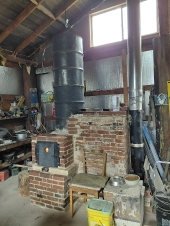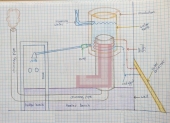Should clarify some of the things above.
Passive solar. The sun directly puts the energy in the area needed. Ideally the sun shines directly on the mass inside (ideally dark mass) an enclosed space (probably thru a window). You could label this one direct solar. Next level down of passive is reflected sunshine on mass. For example right now in the early morning the sun hits the white ceiling of my passive solar home. This light is reflected around the room with some hitting the back wall heating mass directly by reflected light and some hitting furniture carpet etc. Sort of the final level is sun in hits low mass items, they get hot and heat the air, air flows around and heats the mass. Last is very ineffective as if you want to heat tons of mass with air you need to flow tons of air past the mass.
Passive solar done right keeps the sun and its heat outside when you don't want it with no effort on your part and lets it in during the times when you do want it. Because of season lag that may mean you are to hot for a month or 6 weeks or even 2 months in the fall and to cold for the same time period in the spring. For example on the longest day of the year in this house the sun rises north of the house. It doesn't get around to the south side of the house until about 10:30. By which time the eves are shading the top 6 to 8 feet of the wall. This mean the sunlight doesn't even come close to the clerestory windows up high in the wall. On the shortest day of the year the sun comes over the mountain shining on the south wall thru the clerestory windows. As it rise in a flat arc the sun moves across the ceiling while slowly descending on the back wall. At noon the full power of the sun is shining directly right at the top of the back wall directly heating that concrete. Then it moves back up the wall and onto the ceiling toward early evening. From sun up to sun down the light was coming in the clerestory windows.
Now this is a good place to mention other forms of time delay. You have season delay and annualized. For example in annualized geothermal I might be storing heat in the middle of summer for use in the middle of winter. The earth does this naturally about 8 feet down which is why it is supposed to nearly constant at that depth in most places.
Discussion should include solar thermal air based collectors too. Reason is they are easier to retrofit in many cases. Simplest form is a wood box with a glass cover with an absorber in that takes in cold air and puts out warm/hot air.
Solar collectors over heating is only a problem with badly designed systems mostly. A good system self limits and simply shuts down so the heat stays outside instead of hurting anything.
An advantage of good active thermal collectors is if they are well designed you can simple choose to not bring the heat in. Leave it where it is or vent it outside for example.
Should also mention PVT systems. PV is photalvoltaic and the T is thermal so they do both. The PV part gathers roughly 20% of the energy as electricity. The T part gathers another 60+% as heat. At the same time the PV part is kept cooler making it more efficient and also extending its life expectancy.
Then another chart of home energy usage. Notice this one shows way higher heating percentages. But government data so guessing it is likely closer to accurate in this case. This web page has a number of other useful tool for geography etc.
home energy usage US
Calling this good for now but will try and get back to add more.











